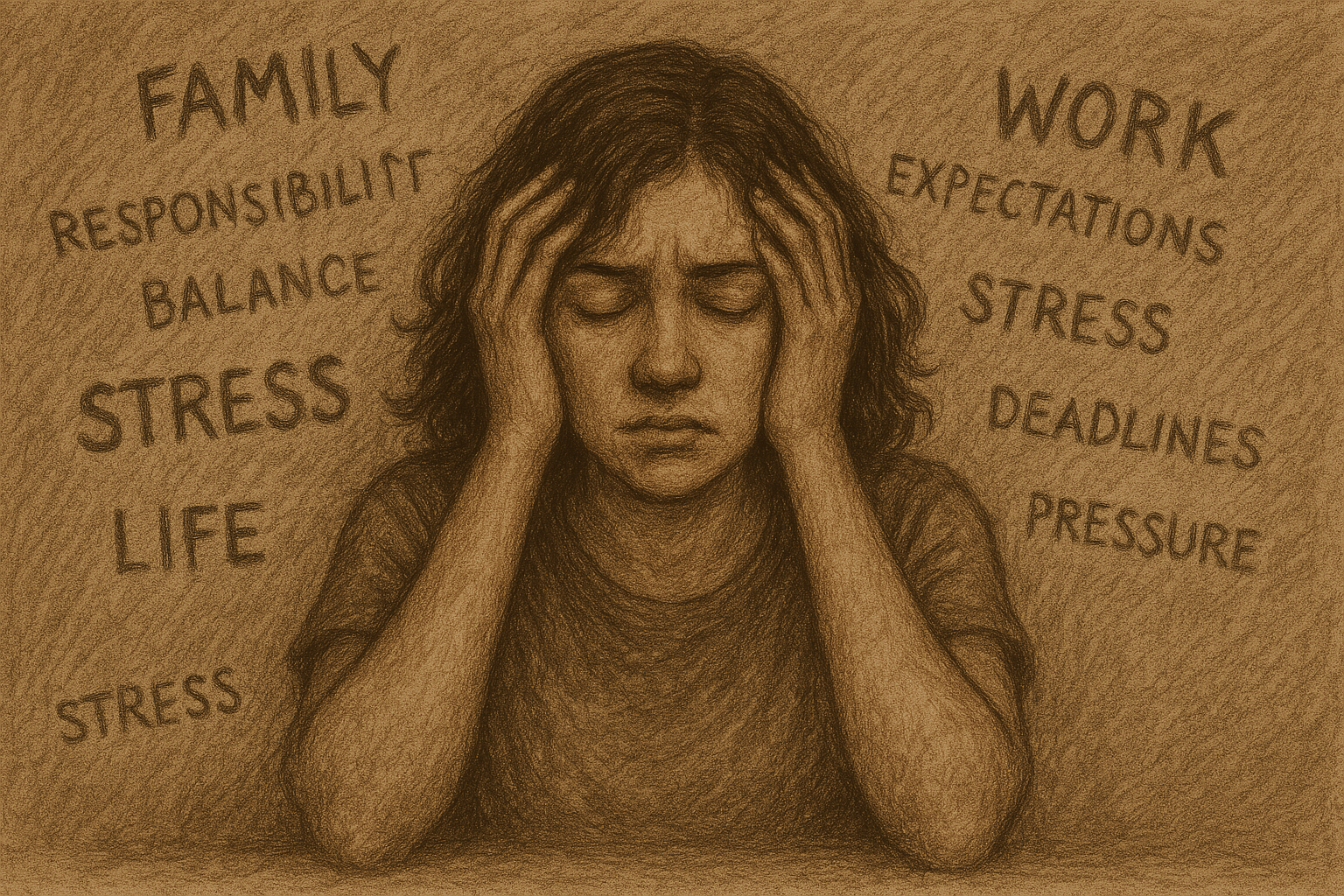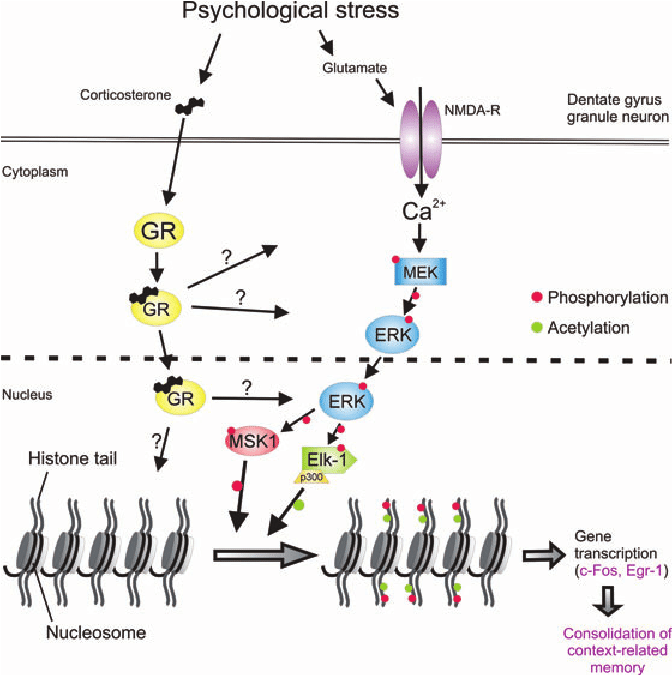
Artstract Created by S. Mohamed
Have you ever noticed how the most stressful or traumatic moments in life tend to stick with you forever? Maybe it was a car accident, a time where you almost drowned, or a time when you were truly afraid. While it might feel like a harsh part of life, science shows there’s a biological reason why these memories are so vivid and lasting.
The paper highlights that stressful experiences initiate powerful molecular changes in the brain that help form long-lasting memories, especially through the activation of glucocorticoid and NMDA receptors, two key players in the memory-encoding process.[1], [2].
What’s Going On in the Brain?
Understanding the relationship between stress and memory starts with the hippocampus, specifically the dentate gyrus, a region critical for memory formation. When we experience stress, like public speaking or being stuck in traffic, the brain releases glucocorticoids (like cortisol). These hormones interact with glucocorticoid receptors (GRs) and NMDA receptors, triggering a powerful signaling cascade called the ERK-MAPK pathway [2], [4].
This pathway transmits signals into the nucleus of neurons, where it leads to a specific epigenetic modification of histone proteins: a dual mark called H3S10p-K14ac. This modification essentially “unlocks” sections of DNA so that crucial immediate early genes (IEGs) like c-Fos and Egr-1 can be transcribed into genes known to be essential for memory consolidation and synaptic plasticity [1],[4].

Figure 1. Psychological stress activates glucocorticoid and glutamate pathways that converge on histone modifications to promote stress-related gene transcription.
Why It Matters to You
This isn’t just fascinating neuroscience; it has real-world implications. The research helps explain why some individuals are more susceptible to PTSD and anxiety disorders after trauma. People with heightened GR/ERK-MAPK signaling might over-consolidate traumatic memories, while those with dysregulated GABA (a calming neurotransmitter) may lack the internal braking system to moderate stress responses [3].
Interestingly, the study also shows that this specific epigenetic switch—H3S10p-K14ac—isn’t used universally across the brain. While many brain regions show c-Fos and Egr-1 activation under stress, only the dentate gyrus requires this epigenetic tag for expression, indicating a uniquely guarded gateway to memory encoding in this area [1].
Another major revelation? Glucocorticoids don’t act alone. They rapidly enhance the ERK-MAPK pathway by physically interacting with phosphorylated ERK, accelerating the stress response and memory formation. This synergy happens within minutes—much faster than traditionally believed for steroid hormones [2].
What You Can Do About It
Thankfully, our brains aren’t helpless in the face of stress. GABA plays a protective role by maintaining inhibitory control in the hippocampus. Drugs like lorazepam (a benzodiazepine) can block stress-induced epigenetic responses, while anxiogenic compounds like FG7142 can amplify them. But you don’t need pharmaceuticals to influence this system.
Natural interventions, like long-term aerobic exercise, mindfulness, deep breathing, and quality sleep all help strengthen GABAergic tone and reduce stress-induced ERK signaling. Rats with access to running wheels showed less stress reactivity in the dentate gyrus, supporting the idea that movement can help buffer the brain from chronic stress [4].
This research doesn’t just explain how stress becomes a memory, it shines a light on how we might intervene. Targeting signaling proteins like MSK1 or transcription factors like Elk-1 could pave the way for new therapies that disrupt maladaptive stress memories while preserving helpful ones [2], [4].

Figure 2. Non-pharmaceutical approaches to anxiety include therapy, alternative treatments, and lifestyle changes that support mental wellness.
The Bigger Picture
We often think of memory as a passive thing events happen, and we either remember or forget. But the truth is, our brains are constantly evaluating which experiences deserve to be encoded. Stressful or emotional events? The brain gives those the red carpet treatment [1].
This molecular precision is part of our evolutionary design it helps us learn from danger. But sometimes, the system overreacts, reinforcing painful memories and fueling cycles of anxiety or trauma. Understanding how stress, hormones, and gene expression intersect gives us the power to reshape how we respond and remember [4].
A Better Ending: Hope for Healing and Resilience
What this research really highlights is that the brain is not static. Stressful experiences can leave deep biological marks, but those marks are not unchangeable. Through interventions like regular exercise, mindfulness, and even potential drug therapies targeting specific molecular pathways, we can change how our brains respond to and store stressful experiences.
In a time where anxiety and trauma are becoming increasingly common, especially among young people, it’s empowering to know that we can take an active role in our mental health. The more we understand about the biology of stress and memory, the better equipped we are to build resilience not just by avoiding stress, but by responding to it in healthier, more adaptive ways.
Stress may be unforgettable, but so is healing. And now, we have a clearer blueprint for how to get there.
References:
- Reul, J. M. H. M. (2014).
Making memories of stressful events: A journey along epigenetic, gene transcription, and signaling pathways.
Frontiers in Psychiatry, 5, 5.
https://doi.org/10.3389/fpsyt.2014.00005 - Gutierrez-Mecinas, M., et al. (2011).
Long-lasting behavioral responses to stress involve a direct interaction of glucocorticoid receptors with ERK1/2-MSK1-Elk-1 signaling.
Proceedings of the National Academy of Sciences, 108(33), 13806–13811.
https://doi.org/10.1073/pnas.1103214108 - McEwen, B. S. (2007).
Physiology and neurobiology of stress and adaptation: Central role of the brain.
Physiological Reviews, 87(3), 873–904.
https://doi.org/10.1152/physrev.00041.2006